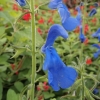Features
This clump forming perennial has soft, mid green leaves which are ovate to triangular in shape. Spikes of strikingly bright blue, two-lipped flowers are held aloft from midsummer into autumn.
What to use it for
Great for beds and borders particularly in a cottage style garden or in a coastal situation. Happy to grow against a sunny wall and will mix well with Mediterranean style plants. Useful for cut flowers. Although a perennial, Salvia patens plants are often used as annual bedding.
How to look after it
This plant will require protection against cold winter temperatures. This can be done either by mulching over the top of the plant with an organic mulch which is around 10cm deep, or by cutting the plant down to ground level and lifting, drying and storing the root tubers over winter.
How to prune it
Deadhead regularly (by removing spent flower spikes) to prolong the flowering period.
How to propagate it
Established plants can be divided in the spring.
Seeds can be collected when ripe. They shed their seeds rapidly so collect the pods daily in the period when flowering is finishing, or tie a paper bag over the flower stems to catch the ripened seeds. Sow them in the spring at around 17°C and keep them in a warm spot to grow on. They should flower about 12 weeks after they were sown.
Basal cuttings can be taken in late spring and, if kept at 15°C while the roots form, they should flower the same year. Softwood or semi-ripe stem cuttings can be taken from non-flowering growth in late summer or early autumn.
Common problems
Salvia plants are generally pest and disease free, although capsid bugs may be a problem.
Other useful information
This plant has been given the ‘Award of Garden Merit‘ by the RHS.
The genus name Salvia derives from the Latin ’salvere’, which means ‘to be in good health’, and probably denotes the herbal, healing use of many Salvia varieties. Salvia patens was first introduced to Europe in 1838.








